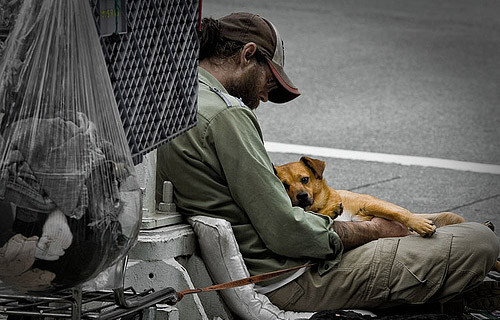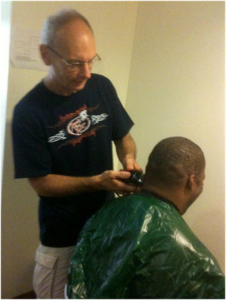
After I wrote CRAZY, I wanted to write a book about homelessness so I contacted Gunther Stern, the Executive Director of the Georgetown Ministry Center [GMC} in Washington D.C. and asked if I could spend some time with him and his staff. Georgetown is one of the wealthiest sections of the nation’s capital. It attracts the homeless because it is a fertile place to panhandle and it is one of the safer areas in the city to sleep outside at night.
Georgetown’s wealthy residents have always been adamantly opposed to having a homeless shelter operate inside their exclusive neighborhood. But after an elderly homeless man died from exposure in 1984 while sleeping in a Georgetown telephone booth, the community was shamed into action. Several churches agreed to open their sanctuaries at night to homeless individuals. Between November and March, churches take turns. For two weeks, a congregation will provide an evening meal and overnight shelter to persons who are in need of lodging. When that congregation’s two-week stint ends, the homeless group moves to the next church. This alleviates the need for a full time shelter by taking care of the homeless during the winter months.
At the time I was doing my research, the Georgetown churches allowed ten homeless persons to be part of their moving church shelter. That was a manageable number for me to follow. I wanted to write a book that would examine those ten persons’ lives, how and why they ended up homeless, and what impact, if any, their two week encounters had on the volunteers in the churches who helped them. I thought it was a brilliant idea and Gunther Stern agreed and offered to introduce me to the ten homeless persons who’d been chosen for the shelter program that year by GMC.
Unfortunately, when I sent my book proposal to my publisher, G. P. Putnam and Sons, it was rejected. I was told that readers would not be interested in plunking down $22.50 to buy a book that described the lives of people who were both “scary” and “clearly disturbed.” As an alternative, it was suggested that I become “homeless” and write about my experiences. At the time, Barbara Ehrenreich’s book, Nickel and Dimed : On (Not) Getting By in America, was on the best seller list. My editor thought that a book where I pretended to be homeless might sell.
There were several reasons why I decided not to do that. How could I really understand the despair that a person feels when they have no safe place to call home? Sleeping on the streets for a few nights might teach me about how uncomfortable and dangerous being homeless could be. It could make me more aware of the hardships. But would it really make me truly understand homelessness?
The fact that I had just invited my elderly parents to live with us also played a factor in my decision to write, instead, The Serial Killer Whisperer.
I’ve always regretted that I wasn’t able to write a book about GMC and those ten homeless persons lucky enough to be part of the church shelter program. But the short time that I spent with Gunther Stern and a young protege of his, Bram Houben, taught me several things that I hadn’t realized about homelessness.
*If a person is homeless and shows up in Georgetown, someone from GMC will contact them without 24 hours after they appear on the streets. When I was doing my research, Gunther and Bram walked the streets of Georgetown two or three times a day. Their mission was to talk to the homeless men and women who they encountered living under bridges or camped in the woods next to the Potomac. They offered them water and told them about GMC services. I had mistakenly assumed that no one knew anything about the homeless individuals roaming the streets.
*All of the homeless individuals I met had an income. They usually got a monthly check because of a disability.
* Everyone of the homeless men who were sleeping outdoors in Georgetown at night — (when I did my research there were no women sleeping outside) — had a diagnosed mental disorder. Most refused medication. Several were convinced that they were not sick. Others talked openly to me about how they had undergone psychiatric treatment in the past, but for a variety of reasons, no longer either were eligible for treatment or didn’t want help. All of the men I interviewed also had a substance abuse or alcohol problem.
*Everyone of the homeless men and women had lived fairly ordinary lives before either their mental illness or their addiction caused them to end up on the streets.
*Despite their illnesses, the men I met followed a rather strict routine. They began their days at a church where they could eat a free breakfast. From there, many of them migrated to a local library where they would look at magazines, sleep, read, or use computers. Next up was a trip to a shelter that served free lunches. Some panhandled in the afternoons usually for money for alcohol or drugs. Others sat on park benches if it was warm and people watched, and a few went to a local Starbucks where they were tolerated as long as they didn’t act inappropriately and were relatively clean. Finally, they ate dinner at another shelter before retiring to the streets where they each had claimed a specific spot as their own. Traveling as a loosely organized team gave them some sense of community. They knew each other, either by sight or name, and often kept track of each other. At the cramped GMC offices, the men were offered a safe place to go during the day to take showers, do laundry, collect mail, and get help from Gunther and his team.
What I saw at GMC helped me later when I served a brief stint on the board of the Corporation for Supportive Housing, a fabulous, national non-profit that is trying to end homelessness by building affordable and transitional housing for persons who are poor, mentally ill or have substance and alcohol abuse problems, are re-entering society after serving jail and prison sentences or are no longer welcome by foster care programs because they have turned 18 years old.
I admire the Gunther Sterns and Bram Houbens of our world who work tirelessly with little recognition or pay to help others. Stern has been a tireless champion for the disenfranchised for years in Georgetown. I regretted that I couldn’t write the book that we both had hoped would be published.

Gunther Stern
I often think about Gunter, GMC, and the Corporation for Supportive Housing at Thanksgiving when we pause and reflect on how fortunate most of us are — especially when compared to persons who have no safe place to live. I was shocked recently when The Washington Post reported that in Fairfax County Virginia — one of the wealthiest counties in America — the number of homeless students in public schools is likely to surpass 2,500 by the end of this school year.
2,500 students with no home. Of them, at least 400 are “unaccompanied youths” who live without parents or guardians. That is shameful!
When you are enjoying Thanksgiving this week, pause for a moment to consider those less fortunate and perhaps make a contribution to GMC or the CSH. It is a good way to return to others some of the blessings that you have received.




Thanks for sharing your experiences despite the fact that the book would not have garnered enough interest to sell many copies (though I know many people would have been interested). I know from reading “Crazy” that your writing style and ability means that any story you approach is interesting and a worthwhile read. Thanks for highlighting the often-forgotten people, and those who tirelessly care for them.
G. P. Putnam and Sons made a poor assessment, they owe it to you to take a chance and right their wrong. My view of the homeless community changed greatly after reading “Crazy”. I could only imagine what else we might learn through a book dedicated entirely to the subject. There may be a solution to the extent of the problem within the dialogue a book like that would generate.
Pete, while reading your blog about Gunther Sterns and Bram Houbens, I thought about the wonderful people here in Auburn doing unsung work for people living in cars, under the thruway bridge or out of a job.
Cayuga County in Auburn, New York has been blessed by two dedicated individuals who work with local homeless men and women. Rhona Prescott is the director of Chapel House (a homeless shelter housing 19 men) and Deb Cornall is director of Daylight House, transitional housing for women and children. Deb was once close to being homeless herself with 3 young children. This NAMI Cayuga County member has converted her home into an apartment which can now house up to 5 women and their children.
The only experience I have ever had with homeless individuals was 2 summers ago when I volunteered one hot July evening to walk the streets of Auburn with 2 individuals from the local homeless task force to do a count. I was shocked when we stumbled upon a homeless man living under the bridge (near the Owasco River which runs through downtown Auburn) next to a prominent restaurant. The man did not want our help so we left informational pamphlets explaining where he could go to get help should he desire it. His image is fixed in my mind.
It is hard to understand why this happens in an affluent society. For me there is no rhyme or reason. But I am grateful for people like Gunther, Bram, Rhona and Deb for stepping up to the plate and making a difference.
Your article is inspirational and G.P. Putnam & Sons missed a tremendous opportunity when they rejected your book idea.
Terri Wasilenko
NAMI Cayuga County
I share your observations about the community that people who are homeless create. I think this is vitally important information for those who want to provide housing. When I rode the homeless bus in Baltimore City, it was apparent that many would not accept housing because they didn’t want to leave the community they had. Also important is to remember that each homeless person has a past and is an individual and needs to be approached accordingly. I ran a program to read people with mental illness [depression, trauma] and /or substance abuse but refused traditional treatment places. We co-located in a trusted community site. Unfortunately, the program was sustained primarily by local foundations and will soon be phased out. The State is not concerned with those who are sick but invisible. Thank you for your blog.
Deborah Agus, JD
Executive Director, Behavioral Health Leadership Institute
Adjunct Faculty, Johns Hopkins School of Public Health